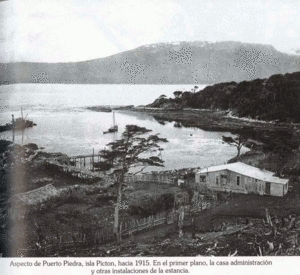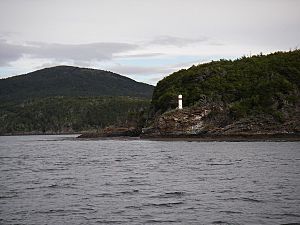Picton, Lennox and Nueva facts for kids
|
Islas Picton, Nueva y Lennox
Nickname: PNL, PLN
|
|
|---|---|

Puerto Piedra on Picton Island in 1915.
|
|
| Geography | |
| Coordinates | 55°02′S 66°57′W / 55.03°S 66.95°W |
| Adjacent bodies of water | Pacific Ocean Atlantic Ocean (to the east of the islands) |
| Administration | |
| Region | Magallanes |
| Province | Antártica Chilena |
| Commune | Cabo de Hornos |
| Additional information | |
| NGA UFI=-896223 (Picton), -893896 (Nueva), -888860 (Lennox) | |
The Picton, Lennox, and Nueva Islands (also called Islas Picton, Nueva y Lennox in Spanish) are a group of three islands. They are located at the very southern tip of South America. These islands are part of Chile, specifically in the Cabo de Hornos area. This area is in the Antártica Chilena Province, which is part of the Magallanes and Antártica Chilena Region.
The islands are found within the Tierra del Fuego group of islands. They are east of Navarino Island. The Beagle Channel separates them from the Argentine part of Isla Grande to the north. Lennox Island is about 170 square kilometers. Picton Island is about 105 square kilometers. Nueva Island is about 120 square kilometers.
Close to these main islands are smaller islands called islets. Some of these islets include Snipe, Augustus, Becasses, Luff, Jorge, Hermanos, Solitario, Gardiner, Terhalten, and Sesambre.
Exploring the History of the Islands
The islands were named by explorers. Robert Fitzroy and Phillip Parker King named Picton Island. They named it after Thomas Picton, who was a British governor. Lennox Island was first found in 1624 by a Dutch admiral named Schapenham. He named it Terhalten. Later, Fitzroy and Parker King gave it the name Lennox.
For many years, from 1881 to 1904, both Chile and Argentina agreed these islands belonged to Chile. This was based on a border agreement signed in 1881.
In the late 1800s, the Chilean government gave land rights to people. Antonio Milicic received land on Nueva Island. Esteban Loncaric got land on Lennox Island. Thomas Bridges received land on Picton Island. By 1910-1911, people lived in small bays on these islands. These places were Caleta Las Casas on Nueva, Puerto Piedra on Picton, and Caleta Oro and Caleta Cúter on Lennox. Caleta means "little bay" in Spanish. Over time, these land rights were given to other business owners. They mainly used the land for raising cattle or for mining.
Puerto Banner: A Historic Stop
From December 3 to 6, 1914, a German naval group stopped at Puerto Banner. This happened after a sea battle called the Battle of Coronel. The German ships were on their way to another battle, the Battle of the Falkland Islands. Chile saw this as breaking its rule of staying neutral in the war.
Because of this, Chile made Puerto Banner a coaling station for its own navy. A coaling station is a place where ships can get coal for fuel. Puerto Banner was also used twice by the ship Yelcho. The Yelcho was helping to rescue the Imperial Trans-Antarctic Expedition led by Ernest Shackleton.
Later, during a land reform in Chile, the eastern part of Navarino Island and the three islands were part of a plan. This plan was to help people settle and develop the area. Puerto Toro, a town on Navarino Island close to the islands, was rebuilt in 1969.
The Islands and International Disputes
The islands are in a very important spot. They are south of the Beagle Channel. They also face the border between the Pacific Ocean and the Atlantic Ocean. Because of their location, Argentina claimed them starting in 1904. This was not based on the 1881 treaty, but for other "political reasons."
Controlling these islands was important. The country that owned them could claim more ocean territory. This was important for fishing. It also meant they could claim other islands and a larger part of Antarctica. Antarctica is important for its resources and for exploration.
The disagreement over the islands continued into the late 1900s. In 1971, the presidents of Chile and Argentina signed an agreement. This agreement was to settle their border dispute. It was also to decide who owned the Picton, Nueva, and Lennox islands. The decision was to be made by Queen Elizabeth II of the United Kingdom.
In 1978, Argentina rejected the Queen's decision. Argentina then started to prepare for war. The three islands, plus the Hermite and Wollastone islands, became Argentina's main targets. To protect themselves, the Chilean Navy placed minefields in important areas on the islands. On December 22, 1978, Argentina began a plan to invade. This plan was called Operation Soberanía. A few hours later, they stopped the invasion.
Even though the operation was called off, Argentina still thought about using military force. After Argentina invaded the Falkland Islands in 1982, they planned to take the three islands. This was confirmed by a high-ranking Argentine military officer. The last minefields were placed shortly after the 1982 invasion of the Falkland Islands. Since 2007, Chile has been clearing these minefields.
The Islands in Literature
The islands are featured in a famous book. "The Survivors of the 'Jonathan'" is a novel by Jules Verne. It was written in 1897 and published in 1909.
The story is about a mysterious man named Kaw-djer. He lives on Nueva Island. His motto is "Neither God nor master." He avoids contact with the outside world. He relies on himself to survive. He also helps the local people of Magellania. However, the 1881 border treaty changes his life. It means the land is no longer "nobody's land." This ends his peaceful way of life.
See also
 In Spanish: Islas Picton, Nueva y Lennox para niños
In Spanish: Islas Picton, Nueva y Lennox para niños
- Operation Soberania
- Beagle Channel cartography since 1881
- Allen Francis Gardiner
- Islands of Chile
- List of islands of Chile




